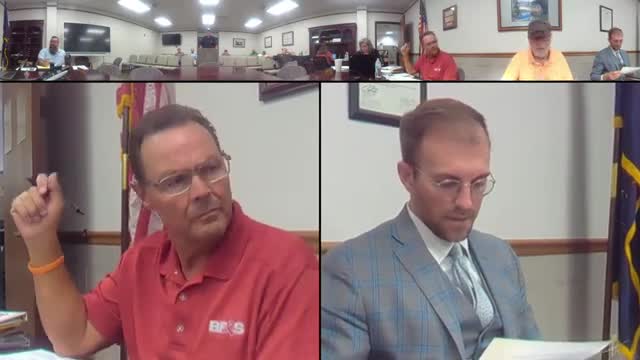Commissioners approve new stop signs at two offset intersections; sheriff proposes automated speed cameras for county roads
October 08, 2025 | Scott County, Indiana
This article was created by AI summarizing key points discussed. AI makes mistakes, so for full details and context, please refer to the video of the full meeting. Please report any errors so we can fix them. Report an error »

The Scott County commissioners approved placing stop signs at two offset intersections after county staff confirmed the locations meet state traffic-control manual criteria. Commissioners voted unanimously to adopt the required ordinance for the intersections (ordinance numbers assigned during the meeting) and to advertise the implementation date; signs and four-way stop markings will be installed and a two-week advanced notice period will precede activation.
Background and data: county staff reported sight-distance measurements, crash history and manual references (state traffic-control manual sections referenced in the record) to justify the changes. One intersection discussed was Slab Road and Cutshaw Road (later referenced in the record as Slab Road and Marshall/Marshfield area) where staff reported numerous crashes over a 10-year period; staff noted a similar safety justification for a second offset intersection where sight distance was below manual recommendations.
Sheriff's office briefing: Sheriff Jerry reported repeated speeding complaints on county back roads and described enforcement limitations due to manpower. He proposed that the county investigate a movable automated speed camera program similar to systems the state uses in construction zones. Sheriff Jerry said such devices would capture license plates, the county would mail a fine to the vehicle owner, and that the fine would be a civil fine only (no points on the owner's driving record); he asked commissioners to authorize staff to research pilot program costs and ordinance requirements. Commissioners expressed support for the sheriff to research the program and return with a plan and cost estimate.
Public comments earlier in the meeting included residents reporting repeated high-speed driving on rural roads and requesting speed-limit changes, traffic-control signs and other traffic-calming measures. Staff reminded residents that speed-limit setting follows state criteria and that certain traffic-calming devices can carry liability concerns and state manual requirements.
Next steps: staff will place stop signs, coordinate signage and send required public notification. The sheriff will prepare a written plan and estimated costs for a movable camera pilot and legal analysis for any county ordinance needed to authorize enforcement.
Background and data: county staff reported sight-distance measurements, crash history and manual references (state traffic-control manual sections referenced in the record) to justify the changes. One intersection discussed was Slab Road and Cutshaw Road (later referenced in the record as Slab Road and Marshall/Marshfield area) where staff reported numerous crashes over a 10-year period; staff noted a similar safety justification for a second offset intersection where sight distance was below manual recommendations.
Sheriff's office briefing: Sheriff Jerry reported repeated speeding complaints on county back roads and described enforcement limitations due to manpower. He proposed that the county investigate a movable automated speed camera program similar to systems the state uses in construction zones. Sheriff Jerry said such devices would capture license plates, the county would mail a fine to the vehicle owner, and that the fine would be a civil fine only (no points on the owner's driving record); he asked commissioners to authorize staff to research pilot program costs and ordinance requirements. Commissioners expressed support for the sheriff to research the program and return with a plan and cost estimate.
Public comments earlier in the meeting included residents reporting repeated high-speed driving on rural roads and requesting speed-limit changes, traffic-control signs and other traffic-calming measures. Staff reminded residents that speed-limit setting follows state criteria and that certain traffic-calming devices can carry liability concerns and state manual requirements.
Next steps: staff will place stop signs, coordinate signage and send required public notification. The sheriff will prepare a written plan and estimated costs for a movable camera pilot and legal analysis for any county ordinance needed to authorize enforcement.
View the Full Meeting & All Its Details
This article offers just a summary. Unlock complete video, transcripts, and insights as a Founder Member.
✓
Watch full, unedited meeting videos
✓
Search every word spoken in unlimited transcripts
✓
AI summaries & real-time alerts (all government levels)
✓
Permanent access to expanding government content
30-day money-back guarantee

